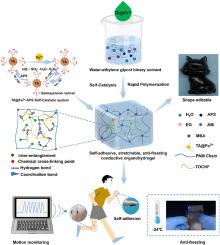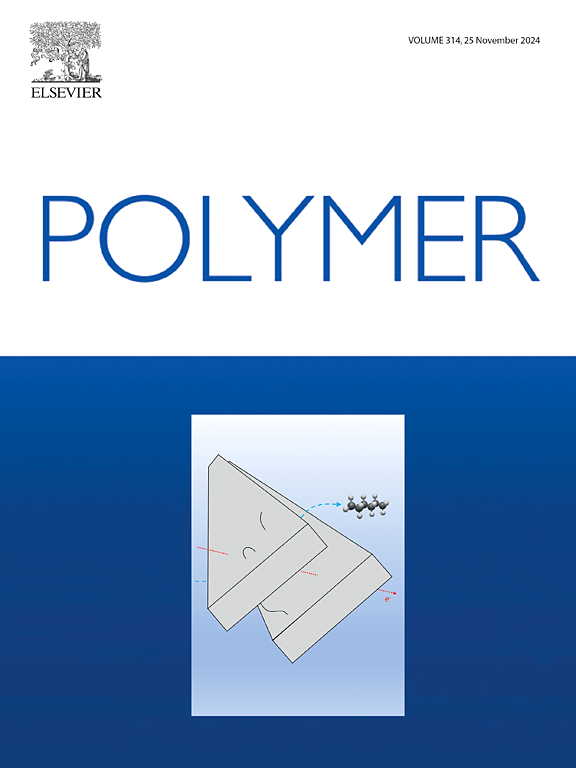Self-Adhesive, Stretchable, Anti-Freezing Conductive Organohydrogels with Fast Gelation from Catechol-Metal Ion Self-Catalytic System for Flexible Strain Sensors
IF 4.1
2区 化学
Q2 POLYMER SCIENCE
引用次数: 0
Abstract
Conductive hydrogels have attracted tremendous attention in flexible sensors due to their flexibility, durability, and multifunctionality. However, time and energy-consumption fabrication process and intrinsic instability in extreme environments severely limit their practical implementations. Herein, a universal and facile synergetic self-catalytic system based on catechol-based molecules and metal ions has been developed to the fast gelation (≈3s) of conductive organohydrogels in water–ethylene glycol (EG) binary solvent, which exhibits excellent stretchability (up to 630% elongation), satisfactory self-adhesion (up to 16.3 kPa), and extreme environment applicability (-80°C to 45 °C). This dual self-catalytic system consists of tannic acid (TA) and ferric ions (Fe3+), which form stable redox pairs to activate ammonium persulfate to generate free radicals, rapidly initiating the polymerization of monomers. Furthermore, the introduction of H2O/EG binary solvent not only facilitates the dispersion of components to improve the mechanical performance of organohydrogels, but also the generation of abundant hydrogen bonds between EG and water molecules endows extreme freezing drying resistance, and enhances self-adhesion for organohydrogels. The organohydrogels showing high sensitivity toward tensile deformation are assembled into flexible strain sensors to detect human motions with high sensitivity, exceptional stability, and excellent durability, which holds great promise in flexible electronics.

用于柔性应变传感器的儿茶酚-金属离子自催化系统可快速凝胶化的自粘性、可拉伸、抗冻导电有机水凝胶
导电水凝胶具有柔韧性、耐久性和多功能性,因此在柔性传感器领域备受关注。然而,耗时耗能的制造工艺以及在极端环境中的内在不稳定性严重限制了它们的实际应用。在此,我们开发了一种基于儿茶酚基分子和金属离子的通用、简便的协同自催化系统,用于在水-乙二醇(EG)二元溶剂中快速凝胶化(≈3s)导电有机水凝胶,该系统具有优异的拉伸性(伸长率高达 630%)、令人满意的自粘性(高达 16.3 kPa)和极端环境适用性(-80°C 至 45°C)。这种双重自催化系统由单宁酸(TA)和铁离子(Fe3+)组成,它们形成稳定的氧化还原对,激活过硫酸铵产生自由基,迅速引发单体聚合。此外,H2O/EG 二元溶剂的引入不仅有利于成分的分散,提高有机水凝胶的机械性能,而且 EG 与水分子之间产生的大量氢键赋予了有机水凝胶极强的耐冷冻干燥性,增强了有机水凝胶的自粘性。将对拉伸变形具有高灵敏度的有机水凝胶组装成柔性应变传感器,可检测人体运动,具有高灵敏度、超强稳定性和出色的耐用性,在柔性电子领域大有可为。
本文章由计算机程序翻译,如有差异,请以英文原文为准。
求助全文
约1分钟内获得全文
求助全文
来源期刊

Polymer
化学-高分子科学
CiteScore
7.90
自引率
8.70%
发文量
959
审稿时长
32 days
期刊介绍:
Polymer is an interdisciplinary journal dedicated to publishing innovative and significant advances in Polymer Physics, Chemistry and Technology. We welcome submissions on polymer hybrids, nanocomposites, characterisation and self-assembly. Polymer also publishes work on the technological application of polymers in energy and optoelectronics.
The main scope is covered but not limited to the following core areas:
Polymer Materials
Nanocomposites and hybrid nanomaterials
Polymer blends, films, fibres, networks and porous materials
Physical Characterization
Characterisation, modelling and simulation* of molecular and materials properties in bulk, solution, and thin films
Polymer Engineering
Advanced multiscale processing methods
Polymer Synthesis, Modification and Self-assembly
Including designer polymer architectures, mechanisms and kinetics, and supramolecular polymerization
Technological Applications
Polymers for energy generation and storage
Polymer membranes for separation technology
Polymers for opto- and microelectronics.
 求助内容:
求助内容: 应助结果提醒方式:
应助结果提醒方式:


